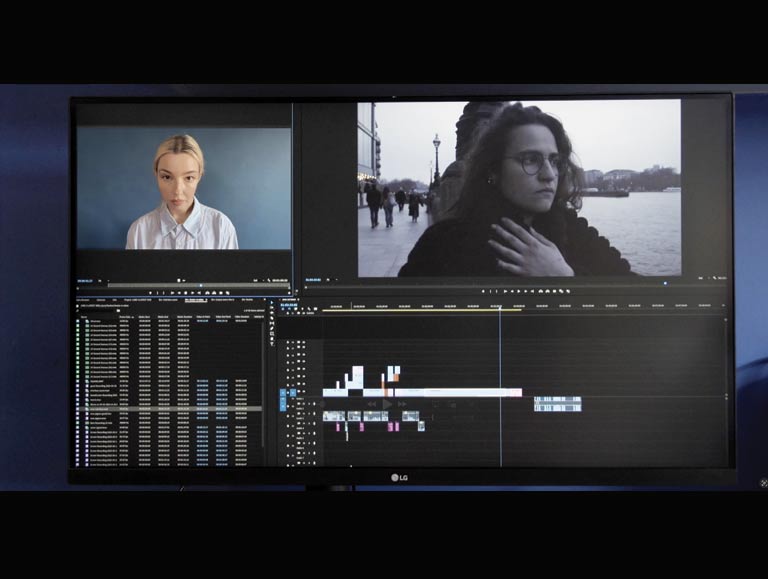“Film begins with the human face,” Ingmar Bergman famously said. But that may be changing in the age of generative AI.
One of the hot-button questions these days is what technological change means for storytelling. And will AI characters, whether you call them Tilly Norwood or something else, ever manage to come across like “humans”? British filmmaker Marc Isaacs (The Filmmaker’s House) explores such themes in his new feature Synthetic Sincerity, which world premieres in the international competition program of the International Documentary Film Festival Amsterdam (IDFA) on Sunday evening.
The hybrid film, blending documentary, fictional scenes, and what is described as “gently absurd humor,” gradually blurs the line between fact and fiction, very much like AI can do, to explore the relationship between humans and machines.
In the film, Isaacs strikes “a deal with The Synthetic Sincerity Lab, an AI research project affiliated with the University of Southern England,” reads a synopsis of the movie, for which Andana Films is handling world sales. “There, researchers are investigating the possibility of teaching AI characters authenticity, using characters from Isaacs’ documentaries to do so. In return, they allow Isaacs to film the process.”
An AI character, created in collaboration with Romanian actress Illinca Manolache, a collaborator of Romanian auteur Radu Jude’s, guides him through this world and “sternly instructs him how to behave there,” the description adds. “Isaacs films the work of the rebellious AI researcher Lynn, and follows an Uyghur chef who puts himself forward as a subject of study. Can this chef, in AI form, put into words what he is unable to express as a human being?”
Adam Ganz wrote the screenplay portions of the film. Isaacs directed it and handled cinematography, plus he edited it together with David Charap.
Watch a trailer for Synthetic Sincerity here.
Ahead of the world premiere, Isaacs talked to THR about Synthetic Sincerity, blurring fact and fiction, his hybrid approach to filmmaking, and what he learned about AI while making the film.
I was curious what was real and fictitious about the collaboration we see you agreeing to in the film, especially because I couldn’t find a school with that name online…
It’s interesting. So Adam Ganz, who’s the writer you see in the film, works at Royal Holloway University, and I used to work there as well, so we’re friends from that time. Some years ago, they won a huge grant to look at new technologies and the future of media, and then a more recent grant. Adam became friendly with Song, the Chinese professor in the film. This AI laboratory he works at is actually at Surrey University.
Adam and I were talking about the next film, because we’ve worked on two previous films together. One was a film I had made in my own home, called The Filmmaker’s House, which looked at how documentary is constructed and questions of truth. The second film was This Blessed Plot, about myth and performance and the boundary between real people playing themselves and not playing themselves.
We thought we had to do something that was looking at what’s happening to the human face and the fact that we’re now looking into the eyes of people that don’t even exist. And what does all of this mean?
What they’re doing in the film is a complete fiction. They don’t work in this area at all. But we spoke to Song about some of our early thoughts, and he was really engaged in what we were doing. So, we came up with the idea of inventing this lab that works with synthetic characters. I mean, somebody’s doing this somewhere. It might look like this or not. Who knows!?
How did you find the students we meet in the film and the name of their lab?
Song said, “I’ve got 18 PhD students who are working on different projects under me. Why don’t you come in and talk to them?” So, the opening scene where I tell them about my filmmaking and I am talking about human faces and showing them some clips, was the first time I met some of his PhD students. That session was filmed very much like a documentary.
Dawn and Pinaki [who are part of the film] became characters that we followed up on. And Song was playing the role of the head of the lab. And then we thought we should give it a name. So we called it the Synthetic Sincerity Lab. And then we invented this university, the “University of Southern England.” And yeah, that doesn’t exist.

‘Synthetic Sincerity’
Do you like mixing genres and doc and fiction?
We’d worked with real people playing roles before in the previous two films. And then we just thought more and more about what kind of film we could make that explores themes and questions of authenticity. And also, what’s happened and what’s going to happen to film?
So, this is now a trilogy of films, so to speak?
Not that we started off with that idea. But for sure. Actually, I’m writing a book at the moment about the three films together.
How did you come up with the female AI character you talk to in the film? I got some Max Headroom vibes watching her…
We were thinking it would be interesting if this lab had made a character that somehow pulls me into this world, you know. There’s a website called Synthesia, where you can make an avatar. We’d created this character with it, but I wasn’t entirely happy with it, because it was quite limited and I just couldn’t quite get the range of emotions. In the meantime, I’d gone to Romania to present some of my films at the One World Romania Festival in Bucharest.
I got to know Illinca Manolache there, who has acted for Radu Jude. So I filmed her, when it occurred to me one day that she would be great to play the avatar. I filmed her with her hair tied back to get the raw data that you need to then put her into an AI. And then I could type in our script and make the AI character [say things]. And she was totally up for it.
What did you do with her voice?
I didn’t want her to sound Romanian. I wanted it to be an accent that you couldn’t really place. So I found this setting that was actually a Dutch person speaking English. So, basically, she’s a hybrid. She’s an actress playing an AI that has been put through the AI. Yeah, she’s a kind of hybrid in herself.
What do you call your hybrid approach? What would you call Synthetic Sincerity? Or maybe we don’t need labels…
I call it a documentary fiction, just because it’s useful to have a label sometimes. But it is all just simply film.
Have you seen the poster for the film? It’s a picture of the two Lumière brothers, with one saying to the other: “You know, Auguste, sincerity is the key to documentary cinema.” And the other one says: “Yes, Louis, and if we can fake that, we’ve got it made.”
In a documentary, you also always have to think about construction and editing. You film somebody and you probably film 10 percent of their life that you’re interested in; the rest is not part of the themes that you’re dealing with, so it won’t be in the film. So it’s all kind of fiction in some way. Yeah, not to say that. You know what’s kind of motivating? Everything is tapping into themes that you think are truthful or important or whatever.

‘Synthetic Sincerity’
Given your work with and on AI, what’s your latest take on what it will mean for film, and is it positive or negative?
Both. It’s so early to really understand what’s going on, but I think that, like any tool, it takes things in a different direction. Potentially, it could be really interesting, but it will also probably be terrible. It is really interesting to think about how we might suspend our disbelief. We do it in fiction all the time. [Pier Paolo] Pasolini said we’re always watching a bit of documentary as well, because we’re also seeing the actor perform. So we can’t really separate that out. So, it’s probably both terrifying and interesting at the same time.
Anything else you’d like to share before I let you go?
There’s this bigger question around what is happening to the medium [of film] and to images and to representation. If you think about it, AI isn’t even representation, is it? Because it’s not representing anything. It’s creating things from scratch. That political question of how one receives images and what it means is so important. We have to think about these questions.
I have kids, and they’re quite literate. They can tell very quickly what’s what, even when they mess around making little movies on their phones, editing and working out how things are put together. Still, it can be very dangerous if we don’t really reflect on these things.

